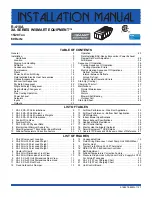
Water may drip from the discharge pipe of the pressure relief device. This pipe must be left open to the atmosphere. The pressure relief device is
to be operated regularly to remove lime deposits and to verify that it is not blocked.
G3 REQUIREMENT
"....there shall be precautions... to ensure that the hot water discharged from safety devices is safely conveyed to where it is visible but will not
cause danger to persons in or about the building."
The following extract is taken from the latest G3 Regulations
Discharge pipes from safety devices
Discharge pipe D1
3.50 Each of the temperature relief valves or combined temperature and pressure relief valves specified in 3.13 or 3.17 should discharge either
directly or by way of a manifold via a short length of metal pipe (D1) to a tundish.
3.51 The diameter of discharge pipe (D1) should be not less than the nominal outlet size of the temperature relief valve.
3.52 Where a manifold is used it should be sized to accept and discharge the total discharge from the discharge pipes connected to it.
3.53 Where valves other than the temperature and pressure relief valve from a single unvented hot water system discharge by way of the same
manifold that is used by the safety devices, the manifold should be factory fitted as part of the hot water storage system unit or package.
Tundish
3.54 The tundish should be vertical, located in the same space as the unvented hot water storage system and be fitted as close as possible to, and
lower than, the valve, with no more than 600mm of pipe between the valve outlet and the tundish (see fig 11).
Note: To comply with the Water Supply (Water Fittings) Regulations, the tundish should incorporate a suitable air gap.
page 14
3.55 Any discharge should be visible at the tundish. In addition, where discharges from safety devices may not be apparent, e.g. in dwellings
occupied by people with impaired vision or mobility, consideration should be given to the installation of a suitable safety device to warn when
discharge takes place, e.g. electronically operated.
Discharge pipe D2
3.56 The discharge pipe (D2) from the tundish should:
(a) have a vertical section of pipe at least 300mm long below the tundish before any elbows or bends in the pipework (see fig. 11); and
(b) be installed with a continuous fall thereafter of at least 1 in 200.
3.57 The discharge pipe (D2) should be made of:
(a) metal; or
Содержание 1000 Indirect
Страница 2: ......
Страница 11: ......
Страница 13: ...Figure 3 Indirect wiring diagram 1 Thermostat Option 2...
Страница 15: ...Figure 4 Single phase wiring schematic...
Страница 18: ...2 port zone valve...
Страница 19: ......
Страница 24: ......
Страница 31: ......
Страница 35: ...Figure 12 Auxiliary controls...
Страница 36: ...Figure 13 Indirect controls page 18 8 Operation 8 1 General...
Страница 45: ...3 7 8 Part No See table Part No 95 605 176 9 12 13 Part No See table Part No 95 605 182...
Страница 46: ...14 15 Part No 95 607 367 Part No 95 607 425 16 18 19 21 Part No See table Part No See table...
Страница 47: ...22 23 24 Part No 95 605 192 95 605 194 Part No 95 605 103 25 26 Part No 7033371 Part No 95 612 650...
Страница 48: ...27 28 Part No 95 612 652 Part No 95 605 884 29 30 31 Part No 7031564 7031565 Part No 95 607 690...
Страница 49: ...32 33 Part No 95 607 691 Part No 95 980 025 34 35 36 Part No 95 980 009 Part No 95 607 366 95 607 404...
Страница 51: ...page 27 page 28 page 29 MAINS PRESSURE HOT WATER STORAGE SYSTEM COMMISSIONING CHECKLIST...
Страница 52: ......
Страница 54: ......
















































